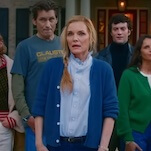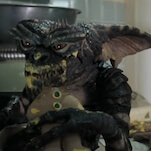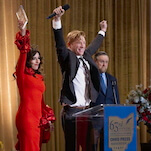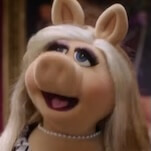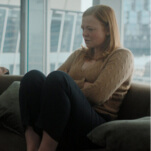(“The One With The Dozen Lasagnas,” season one, episode twelve; originally aired 1/12/95 / “The One With The Boobies,” season one, episode thirteen; originally aired 1/19/95)
Joe: So much of Friends has seeped into the collective unconscious that it genuinely surprises me to find two consecutive episodes whose main plots I largely don’t remember. I mean, yes, obviously The Fall of Paulo, wherein he goes to Phoebe for a professional massage and ends up feeling her buttocks or maybe more is a major plot point in the first season and highly memorable. The only other major plot in “Dozen Lasagnas” is not even the titular abundance of pasta (one of the show’s all-time worst teases; don’t sell me on lasagna and then relegate lasagna to background status!), but rather the origin story for the foosball table, which turns out to be yet another iteration of the friendship-as-romantic-relationship structure, which we’ve already seen at least twice in this relatively young season. Yes, it’s true that the roommate relationship can certainly begin to mirror boyfriend/girlfriend (or boyfriend/boyfriend) interaction, but we’re running the risk of grinding an already worn premise into unrecognizable parts by now. Though it is great to see the Monica Is Scary Competitive personality trait begin to take shape.
Back to Paulo, though. I’m not sure it’s my status as a Ross agnostic that makes me feel this way, but I absolutely thought the most interesting angle on the Rachel/Paulo breakup was not that Ross was once again free to wussily not pursue her, but rather the way Phoebe and Rachel worked through the awkwardness of Phoebe having to tell Rachel that not only was Paulo a wretched creeper, but that he was a wretched creeper with her. Even this time around, knowing full well how this all turns out, I was worried that Rachel was going to somehow blame Phoebe and we’d have to work through a whole bunch of unpleasant drama. There were real stakes in that conversation, even if those stakes were camouflaged by an extended discussion on Phoebe’s out-of-this-world oatmeal raisin cookies.
As for Ross, I keep thinking of your observations last week, Sonia, about how Marcel was indicative of a show that has to keep Ross/Rachel in a holding pattern until the end of the season. You would think that Rachel dumping Paulo would offer forward momentum in the Ross/Rachel storyline, but once again, Ross gets cold feet (admittedly, after Rachel adamantly states that she needs time away from men). This kind of arbitrary wheel-spinning on sitcoms drives me crazy. I’d rather Rachel has stuck with Paulo (I KNOW!) than have the obstacle in the relationship be that Ross is just too good of a guy to bother Rachel with his feelings for her. Maybe it’s realistic. Maybe it’s true to his character. But it’s maddening.
Sonia: It is maddening. Maybe I’ve lost all my patience for the sitcom will-they-won’t-they, but yanking us about with Paulo feels unnecessary. I imagine they only had the actor for a four-episode arc, but all that demonstrates to me is once again how much Friends is shaped by the network. It’s a vehicle for profit, and this is how the vehicle is driven. But too much jerking around tires out fans and loses viewers, so the show then has to get us invested in alternative friendships, I guess.
I too loved the scene where Phoebe confesses to Rachel that this terrible thing has happened; Lisa Kudrow and Jennifer Aniston are both strong actresses, and they work off of each other well in this role. It’s really, really quite astonishing that this revelation doesn’t lead to friction between Rachel and Phoebe. Their conversation reminds me of the conflict between Ross and Chandler last week, too. And I have to say—given how formulaic Friends is at times, the fact that the individual friendships within the group have their own pairwise dynamics that are expressed differently in terms of conflict and connection is remarkable.
For example, I wonder if we would have seen friction if Monica were one of the women in the conflict instead. My hunch is yes; Monica’s consistently written as a far more uptight character, even though all the facts of her life point to her being far more figured out and at peace with herself than the script gives her credit for. But so many other shows have been so casual with how they sketch out character, choosing instead to double down on the farce, the “situation” part of situational comedy. Friends invests in character. It’s a long-term investment that sometimes leads to gags that fall a little short, but it also gives the show the staying power it needs to run for ten seasons.
Joe, I just did math for the first time in a decade, because this line of reasoning made me think about how the six friends can be thrown together to form comedic situations. Presumably each Friend has a unique relationship with every other Friend—we’ve seen this to be true so far—so there are 15 one-on-one relationships in the show between the six main characters, which is a lot of ground to cover. (I arrived at this number using a formula, but then I checked by making a very long list, because I wasn’t sure if the formula I used was the right one. Math!)
Friends doesn’t develop all 15 of them equally—which is unfortunate!—but at the same time, in this bright and idealistic first season, it’s possible to see how the writers were laying out groundwork for these relationships. Add to each coupling the dynamics of all the possible trios and you suddenly have 35 combinations that can go to the races virtually anytime. Okay, yes. I just explained the value of an ensemble cast. But the point is, Friends theoretically places all of our characters on an equal playing field at the start, so even though there’s familial and romantic connections, the possibilities feel endless in a way that a show like Modern Family for example doesn’t quite have going for it. Community, meanwhile, is a show that always made excellent use of its ensemble cast, using the individual relationships as an opportunity to make each adventure novel and interesting. Hm, perhaps I should start a spinoff of these reviews called “Other Sitcoms Friends Sometimes Makes Me Think Of."
JR: “The One With The Boobies” was even more foreign territory to me than “Dozen Lasagnas.” I just flat don’t remember it. And despite the fact that once again the plot line the title refers to is the weakest (how are you going to do a running gag about walking in on someone naked less than a year removed from Seinfeld’s “The Hamptons”), I was really charmed by the rest of it. You knew we were going to run into the Tribbiani family at some point. I just assumed it would be one of the episodes with all of Joey’s loud sisters. No, instead, in a triumph of guest casting we get Joe Sr. (Robert Costanzo), his longtime mistress Roni (Lee Garlington), and finally, Mrs. Trib herself (Brenda Vaccaro).
As with the Rachel/Phoebe plot in the previous episode, Friends seems determined not to follow the expected beats. Joey’s reaction to the news that his dad has been keeping a mistress all these years is genuine, but he’s also pretty understanding when Joe Sr. explains that he’s quite simply in love with two women. There’s an interesting parallel to the show’s tendencies to lean heavily on “Sex in the ‘90s” talk in the early episodes. This plot is more “Sex in the Early to Mid-‘60s,” but it’s still handled largely seriously, with the comedy coming more from the idea of Joey acting like the parent around Joe Sr. and Roni than anything that belittles the adults and their emotions. Even Gloria gets to be open-minded about it, revealing to Joey that she knew all along and, while it’s not her ideal, she looks at how the situation benefits her. I’m not sure how any of this tracks with 2013 gender politics. There’s an easy read on this episode that says it whitewashes the philandering husband by making both of his women (and eventually his son) largely okay with his cheating. But the way the show rolled it out, I found the whole thing rather touching.
The Fisher Stevens subplot is just incredibly funny, as most of the Phoebe stuff has been this season. Is it maybe a little early in the series’ run to be delivering meta-commentary on the characters’ tendencies (not to mention their giant mugs of coffee)? Perhaps. But by the time Stevens gets to psychoanalyzing the Friends, and one by one they grow to just hate him for it, I kind of don’t care. Did the meta bother you?
SS: No—I adored it, to be honest. It’s just so accurate, and I love that the show is kind of playing with giving each of these characters a psychology and also making fun of it at the same time. It also speaks to how unprepared they all are to really grow up and confront their issues. The best thing about Friends is that often they’re forced to anyway. The worst thing about Friends is that the show does not, in the end, really follow through with giving them all a chance to grow up and confront their obvious demons. There’s a point in the middle where they sort of do, but by the tenth season, I feel that everyone’s actually enmeshed even more in their terrible issues.
I never noticed this the first time around, but the writers this season love juxtaposing “group” episodes with “external” episodes. It’s sort of like the kids’ table and the adults’ table. “Boobies” (despite the juvenile title) is the latter, bringing in the Tribbiani family to add some real-world drama. The episode is interestingly kind of—well, not exactly Freudian, but Joey certainly has to come to terms with the frailty of his parents. These family situations reveal these lingering doubts for so many of the characters—doubt in the promise of the Baby Boomers, at times, as well as the uncertainty as to whether or not they’ll ever actually grow up. Surprisingly Joey ends up being the most empathetic character in this episode, channeling this insecurity through his parents and a few extremely affecting interactions with a sofa bed. That silent shot where Joey can’t get the sofa bed back into the couch, followed by his mother’s efficient manipulation of the thing, to put it where it belongs, is a perfect encapsulation of the tensions of the show. They’re sort of adults that kind of know how things are supposed to work, but they’re still not their parents—and that’s okay.
Stray Observations
- “Co-dependent, emotionally stunted, sitting in your stupid coffee house, with your stupid big cups, which, I’m sorry, might as well have nipples on them! And you’re all like, ‘Oh, define me! Define me! Love me! I need love!”
- Is this the first time we see Chandler and Joey’s apartment? I think it is! Man, it’s so much shabbier than Monica’s. [SS]
- Ross to Paulo: “I think I speak for everyone when I say [closes door].”
- This is the last thing I’ll say about numbers—the other most important combination of Friends in the group is the five-against-one dynamic, such as: Everyone goes to see Joey’s play, everyone knows about the sex of the baby except Ross, everyone knows about Paulo except Rachel. Each Friend has a relationship to the group, and that makes for added fun and games. Once I figure out what a factorial is I'll write more about this. [SS]
- “Easy on those cookies, Mon. Remember, they’re just food. They’re not love.”
- Am I being too sensitive about the lesbian jokes on this show? The thing about Ross mistaking Carol and Susan’s friend for Huey Lewis would probably be funnier on a show with a lesbian or two as a protagonist and not just as occasional plot obstacles for Ross. [JR]
- People of Color on Friends watch: 0.



















